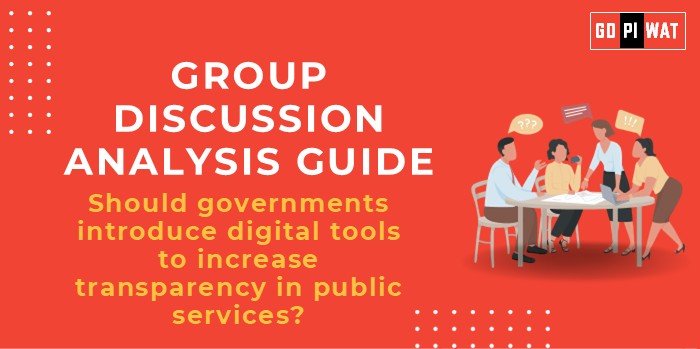📋 Group Discussion (GD) Analysis Guide
Topic: Should Governments Introduce Digital Tools to Increase Transparency in Public Services?
🌟 Introduction to the Topic
Context: In a world increasingly driven by digital innovation, governments face mounting pressure to leverage technology for transparent governance. Digital tools promise efficiency, accountability, and public trust but also bring challenges like data security and inclusivity.
Background: Initiatives like India’s Digital India, Estonia’s e-Governance, and blockchain-based public service models demonstrate the transformative potential of digital transparency.
📊 Quick Facts and Key Statistics
- 🌐 Global Digital Adoption: 64% of the global population now uses the internet, facilitating digital governance (ITU, 2023).
- 📱 India’s Progress: UPI processes 11.5 billion transactions monthly, reflecting increasing trust in digital systems.
- 💻 E-Governance Success in Estonia: 99% of public services are online, saving 2% of GDP annually (UN E-Government Survey, 2023).
- ⚠️ Cybersecurity Concerns: AIIMS cyberattack in 2022 disrupted services for weeks, highlighting risks.
👥 Stakeholders and Their Roles
- 🏛️ Government Agencies: Policy formulation, infrastructure deployment, and citizen awareness campaigns.
- 💼 Private Sector: Developing secure platforms and technology solutions.
- 👥 Citizens: Beneficiaries of transparent systems and key to reporting inefficiencies.
- 🌍 International Organizations: Share best practices and provide funding/support.
✅ Achievements and Challenges
🏆 Achievements:
- 📈 Improved Accountability: Tools like DigiLocker and DBT saved India ₹2.7 lakh crore by reducing leakages.
- 🌐 Accessibility: Estonia’s online services reduced administrative costs by 80%.
- ⏩ Faster Service Delivery: Rajasthan’s digital districts reduced delivery time by 45%.
⚠️ Challenges:
- 🔐 Cybersecurity Vulnerabilities: Example: AIIMS cyberattack.
- 🌍 Digital Divide: Only 20% of rural Indian households have stable internet access.
- 🏢 Resistance to Change: Among bureaucracies.
📌 Structured Arguments for Discussion
- 🔹 Supporting Stance: “Digital tools significantly reduce corruption by providing transparent workflows and traceability.”
- 🔹 Opposing Stance: “The effectiveness of these tools is undermined by weak cybersecurity frameworks and the digital divide.”
- 🔹 Balanced Perspective: “While digital tools enhance transparency, robust infrastructure and inclusive policies are prerequisites for success.”
🗣️ Effective Discussion Approaches
- 📈 Opening Techniques:
- Highlight global benchmarks (e.g., Estonia’s e-Governance).
- Start with striking statistics (e.g., ₹2.7 lakh crore savings via DBT).
- 🔄 Counter-Argument Handling:
- Acknowledge limitations like cybersecurity risks.
- Propose solutions: blockchain, AI-based security systems.
🔍 Strategic Analysis of Strengths and Weaknesses
- 💪 Strengths: Cost efficiency, faster service delivery.
- ⚠️ Weaknesses: Cybersecurity gaps, low digital literacy.
- 🌟 Opportunities: Blockchain for transparency, AI integration.
- ⚡ Threats: Data breaches, resistance to adoption.
📚 Connecting with B-School Applications
- 📂 Real-World Applications: Aligning digital governance with operations management and ethical practices.
- ❓ Sample Interview Questions:
- “How can digital transparency reduce corruption?”
- “Evaluate blockchain’s role in public services.”
- 💡 Insights: Digital governance projects provide exposure to operations, cybersecurity, and public policy.


